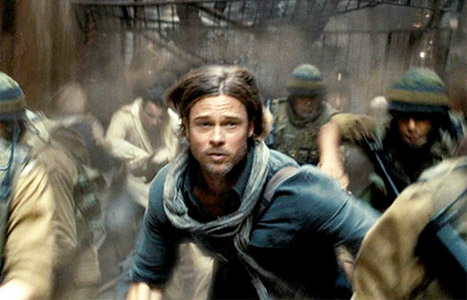The first problem you encounter with World War Z, the new action blockbuster starring Brad Pitt, is how to pronounce the damn thing. Should the last letter be said “zee”, to sound like “three”, or “zed”, to sound like “dead”, or “zzz”, to sound like the audience?
Whichever phoneme you plump for, the Z stands for zombie, and the film contains, on a rough estimate, hundreds of thousands of them. It is based on a novel by Max Brooks, son of the filmmaker and humourist Mel, and it follows Gerry Lane (Pitt), a flaxen-haired former United Nations action man who is recalled to the line of duty when a mysterious pandemic turns citizens of various countries into walking, chomping corpses.
Brooks’s novel was a thinly-veiled parable about American foreign policy and post-millennial anxiety, told from several points of view: in fact, it had much in common with Steven Soderbergh’s terrific 2011 medical thriller Contagion. Marc Forster’s film junks the satire and multiple perspectives, and instead recasts the story as an uncomplicated globe-trotting thriller. On one side we have Lane and a roster of temporary sidekicks, and on the other, an inexhaustible supply of the living dead.
What we get is a collection of moderately violent action set-pieces untroubled by humour or broader coherence. Lane travels from Philadelphia (played on-screen by Glasgow) to Nova Scotia via New York, New Jersey, South Korea, Israel and Wales, and almost nothing that happens along the way has the slightest effect on the film’s final outcome. Perhaps this should come as no surprise: shortly after filming on World War Z was thought to be complete, seven weeks of extra shooting took place in Budapest, which was followed by the writing and filming of an entirely new third act later in the year. Whatever direction the film was originally headed in, someone important obviously thought better of it.
Forster, who directed the Bond film Quantum of Solace, has done his best to piece together a story from these incompatible parts, but the final product has an elaborate uselessness about it, like a broken teapot glued back together with the missing pieces replaced by parts of a vacuum cleaner.
The Welsh finale, in particular, looks spectacularly cheap, and the screen-stretching vistas and computer-generated hordes from earlier in the movie are nowhere to be seen. In their place is Peter Capaldi, who plays a World Health Organisation director hiding out in a bunker near Cardiff, and when you first glimpse him in an otherwise empty office you wonder if Malcolm Tucker has somehow saved the day by swearing the zombies into submission.
By that point you’re well-primed for such silliness, as many of the film’s key dramatic moments wouldn’t feel particularly out of place on a horror-themed edition of The Thick Of It. In one early sequence, when Lane tries to creep past a crowd of zombies on a military base, his cover is blown when his wife Karen (Mireille Enos) unexpectedly rings his mobile. Moments earlier, an important character trips up and accidentally shoots himself in the head, and you start to question whether the planet might in fact be safer in the hands of the zombies.
At least the film has one neat trick: in the Israel sequence we see Boschian wide-shots of zombie hordes coursing down streets and sluicing over barriers like a great, monstrous flood. This chimes with the footage of swarming insects in the opening titles, and suggests that the film may have once had a point to make before the rot set in. But there’s no heart to be found amid the guts.

